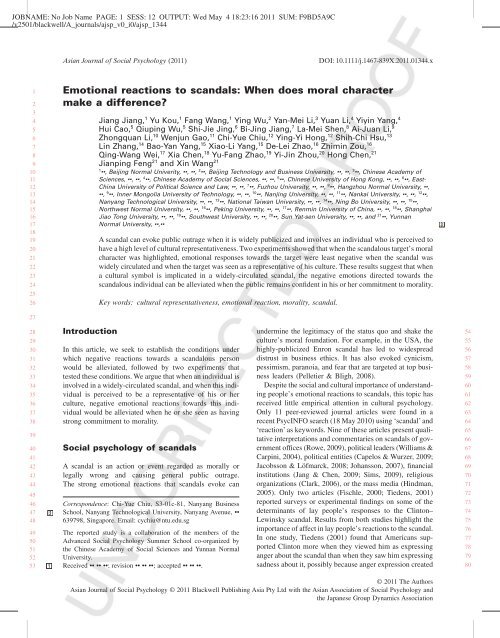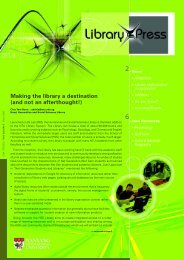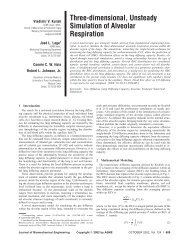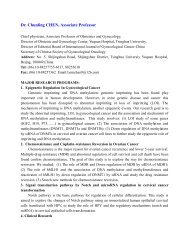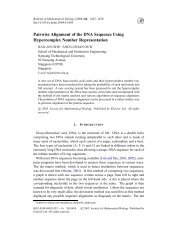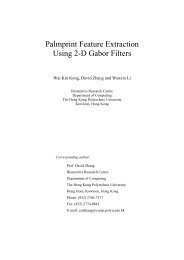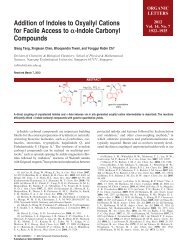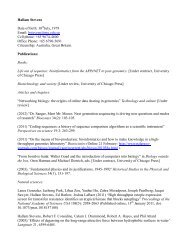Emotional reactions to scandals: When does moral character make ...
Emotional reactions to scandals: When does moral character make ...
Emotional reactions to scandals: When does moral character make ...
You also want an ePaper? Increase the reach of your titles
YUMPU automatically turns print PDFs into web optimized ePapers that Google loves.
JOBNAME: No Job Name PAGE: 1 SESS: 12 OUTPUT: Wed May 4 18:23:16 2011 SUM: F9BD5A9C<br />
/v2501/blackwell/A_journals/ajsp_v0_i0/ajsp_1344<br />
1<br />
2<br />
3<br />
4<br />
5<br />
6<br />
7<br />
8<br />
9<br />
10<br />
11<br />
12<br />
13<br />
14<br />
15<br />
16<br />
17<br />
18<br />
19<br />
20<br />
21<br />
22<br />
23<br />
24<br />
25<br />
26<br />
27<br />
28<br />
29<br />
30<br />
31<br />
32<br />
33<br />
34<br />
35<br />
36<br />
37<br />
38<br />
39<br />
40<br />
41<br />
42<br />
43<br />
44<br />
45<br />
46<br />
47<br />
48<br />
49<br />
50<br />
51<br />
52<br />
53<br />
Asian Journal of Social Psychology (2011) DOI: 10.1111/j.1467-839X.2011.01344.x<br />
<strong>Emotional</strong> <strong>reactions</strong> <strong>to</strong> <strong>scandals</strong>: <strong>When</strong> <strong>does</strong> <strong>moral</strong> <strong>character</strong><br />
<strong>make</strong> a difference?ajsp_ 1..11<br />
Introduction<br />
Jiang Jiang, 1 Yu Kou, 1 Fang Wang, 1 Ying Wu, 2 Yan-Mei Li, 3 Yuan Li, 4 Yiyin Yang, 4<br />
Hui Cao, 5 Qiuping Wu, 5 Shi-Jie Jing, 6 Bi-Jing Jiang, 7 La-Mei Shen, 8 Ai-Juan Li, 9<br />
Zhongquan Li, 10 Wenjun Gao, 11 Chi-Yue Chiu, 12 Ying-Yi Hong, 12 Shih-Chi Hsu, 13<br />
Lin Zhang, 14 Bao-Yan Yang, 15 Xiao-Li Yang, 15 De-Lei Zhao, 16 Zhimin Zou, 16<br />
Qing-Wang Wei, 17 Xia Chen, 18 Yu-Fang Zhao, 19 Yi-Jin Zhou, 20 Hong Chen, 21<br />
Jianping Feng 21 and Xin Wang 21<br />
1 , Beijing Normal Univerity, , , 2 , Beijing Technology and Business University, , , 3 , Chinese Academy of<br />
Sciences, , , 4 , Chinese Academy of Social Sciences, , , 5 , Chinese University of Hong Kong, , , 6 , East-<br />
China University of Political Science and Law, , , 7 , Fuzhou University, , , 8 , Hangzhou Normal University, ,<br />
, 9 , Inner Mongolia University of Technology, , , 10 , Nanjing University, , , 11 , Nankai University, , , 12 ,<br />
Nanyang Technological University, , , 13 , National Taiwan University, , , 14 , Ning Bo University, , , 15 ,<br />
Northwest Normal University, , , 16 , Peking University, , , 17 , Renmin University of China, , , 18 , Shanghai<br />
Jiao Tong University, , , 19 , Southwest University, , , 20 , Sun Yat-sen University, , , and 21 , Yunnan<br />
Normal University, ,<br />
A scandal can evoke public outrage when it is widely publicized and involves an individual who is perceived <strong>to</strong><br />
have a high level of cultural representativeness. Two experiments showed that when the scandalous target’s <strong>moral</strong><br />
<strong>character</strong> was highlighted, emotional responses <strong>to</strong>wards the target were least negative when the scandal was<br />
widely circulated and when the target was seen as a representative of his culture. These results suggest that when<br />
a cultural symbol is implicated in a widely-circulated scandal, the negative emotions directed <strong>to</strong>wards the<br />
scandalous individual can be alleviated when the public remains confident in his or her commitment <strong>to</strong> <strong>moral</strong>ity.<br />
Key words: cultural representativeness, emotional reaction, <strong>moral</strong>ity, scandal.<br />
In this article, we seek <strong>to</strong> establish the conditions under<br />
which negative <strong>reactions</strong> <strong>to</strong>wards a scandalous person<br />
would be alleviated, followed by two experiments that<br />
tested these conditions. We argue that when an individual is<br />
involved in a widely-circulated scandal, and when this individual<br />
is perceived <strong>to</strong> be a representative of his or her<br />
culture, negative emotional <strong>reactions</strong> <strong>to</strong>wards this individual<br />
would be alleviated when he or she seen as having<br />
strong commitment <strong>to</strong> <strong>moral</strong>ity.<br />
Social psychology of <strong>scandals</strong><br />
A scandal is an action or event regarded as <strong>moral</strong>ly or<br />
legally wrong and causing general public outrage.<br />
The strong emotional <strong>reactions</strong> that <strong>scandals</strong> evoke can<br />
Correspondence: Chi-Yue Chiu, S3-01c-81, Nanyang Business<br />
School, Nanyang Technological University, Nanyang Avenue,<br />
639798, Singapore. Email: cychiu@ntu.edu.sg<br />
The reported study is a collaboration of the members of the<br />
Advanced Social Psychology Summer School co-organized by<br />
the Chinese Academy of Social Sciences and Yunnan Normal<br />
University.<br />
Received ; revision ; accepted .<br />
undermine the legitimacy of the status quo and shake the<br />
culture’s <strong>moral</strong> foundation. For example, in the USA, the<br />
highly-publicized Enron scandal has led <strong>to</strong> widespread<br />
distrust in business ethics. It has also evoked cynicism,<br />
pessimism, paranoia, and fear that are targeted at <strong>to</strong>p business<br />
leaders (Pelletier & Bligh, 2008).<br />
Despite the social and cultural importance of understanding<br />
people’s emotional <strong>reactions</strong> <strong>to</strong> <strong>scandals</strong>, this <strong>to</strong>pic has<br />
received little empirical attention in cultural psychology.<br />
Only 11 peer-reviewed journal articles were found in a<br />
recent PsycINFO search (18 May 2010) using ‘scandal’ and<br />
‘reaction’ as keywords. Nine of these articles present qualitative<br />
interpretations and commentaries on <strong>scandals</strong> of government<br />
offices (Rowe, 2009), political leaders (Williams &<br />
Carpini, 2004), political entities (Capelos & Wurzer, 2009;<br />
Jacobsson & Löfmarck, 2008; Johansson, 2007), financial<br />
institutions (Jang & Chen, 2009; Sims, 2009), religious<br />
organizations (Clark, 2006), or the mass media (Hindman,<br />
2005). Only two articles (Fischle, 2000; Tiedens, 2001)<br />
reported surveys or experimental findings on some of the<br />
determinants of lay people’s responses <strong>to</strong> the Clin<strong>to</strong>n–<br />
Lewinsky scandal. Results from both studies highlight the<br />
importance of affect in lay people’s <strong>reactions</strong> <strong>to</strong> the scandal.<br />
In one study, Tiedens (2001) found that Americans supported<br />
Clin<strong>to</strong>n more when they viewed him as expressing<br />
anger about the scandal than when they saw him expressing<br />
sadness about it, possibly because anger expression created<br />
© 2011 The Authors<br />
Asian Journal of Social Psychology © 2011 Blackwell Publishing Asia Pty Ltd with the Asian Association of Social Psychology and<br />
the Japanese Group Dynamics Association<br />
3<br />
54<br />
55<br />
56<br />
57<br />
58<br />
59<br />
60<br />
61<br />
62<br />
63<br />
64<br />
65<br />
66<br />
67<br />
68<br />
69<br />
70<br />
71<br />
72<br />
73<br />
74<br />
75<br />
76<br />
77<br />
78<br />
79<br />
80
JOBNAME: No Job Name PAGE: 2 SESS: 12 OUTPUT: Wed May 4 18:23:16 2011 SUM: 95CC566F<br />
/v2501/blackwell/A_journals/ajsp_v0_i0/ajsp_1344<br />
1<br />
2<br />
3<br />
4<br />
5<br />
6<br />
7<br />
8<br />
9<br />
10<br />
11<br />
12<br />
13<br />
14<br />
15<br />
16<br />
17<br />
18<br />
19<br />
20<br />
21<br />
22<br />
23<br />
24<br />
25<br />
26<br />
27<br />
28<br />
29<br />
30<br />
31<br />
32<br />
33<br />
34<br />
35<br />
36<br />
37<br />
38<br />
39<br />
40<br />
41<br />
42<br />
43<br />
44<br />
45<br />
46<br />
47<br />
48<br />
49<br />
50<br />
51<br />
52<br />
53<br />
4 4<br />
2 Jiang Jiang et al.<br />
the impression that Clin<strong>to</strong>n was a competent leader. In<br />
another study, Fischle) tracked public opinion in the USA in<br />
the wake of the Clin<strong>to</strong>n–Lewinsky affair and found that prior<br />
positive affect for Bill Clin<strong>to</strong>n significantly lowered US<br />
citizens’ appraisal of the credibility and perceived importance<br />
of the allegations against the president. These two<br />
studies showed that lay people’s prior affect <strong>to</strong>wards a<br />
scandalous leader and his post-scandal impression management<br />
could moderate lay people’s <strong>reactions</strong> <strong>to</strong> the scandal.<br />
The present research seeks <strong>to</strong> extend this line of work by<br />
focusing on how the perceived cultural representativeness of<br />
a scandalous person, the perceived circulation of the scandal,<br />
and the <strong>moral</strong> image of the scandalous person jointly influence<br />
lay people’s emotional <strong>reactions</strong> <strong>to</strong> a scandal.<br />
Cultural significance of scandalous<br />
cultural icons<br />
Some <strong>scandals</strong> (e.g. <strong>scandals</strong> of pop singers, sports stars,<br />
rich people) might attract public attention and evoke<br />
amusement because of the news worthiness of the individuals<br />
implicated in the <strong>scandals</strong>. However, <strong>scandals</strong> that<br />
involve im<strong>moral</strong> or unethical behaviours of individuals who<br />
are perceived <strong>to</strong> be representatives of their culture (e.g.<br />
cultural celebrities; political, business, and religious<br />
leaders) often incite public outrage. Although most people<br />
are not officially ordained <strong>moral</strong> representatives of their<br />
culture, at least some people, at their best, are regarded as<br />
sacred symbols that reflect what is held <strong>to</strong> be the best of the<br />
culture and society (Kesebir, in press). Im<strong>moral</strong> acts committed<br />
by these individuals might tarnish the <strong>moral</strong> lustre of<br />
their society. Thus, the society has relatively low <strong>to</strong>lerance<br />
of the <strong>moral</strong> transgressions of these individuals.<br />
In addition, according <strong>to</strong> the intersubjective theory of<br />
cultural processes (Chiu, Gelfand, Yamagishi, Shteynberg,<br />
& Wan, 2010; Wan et al., 2007), every society has a need <strong>to</strong><br />
preserve its core values. A core value in a society is one that<br />
most people in the culture are expected <strong>to</strong> endorse. For<br />
example, filial piety is a core value in Chinese culture, and<br />
most Chinese are expected <strong>to</strong> endorse it. Core values are<br />
instituted in many cultural practices and embodied in many<br />
external media, including the public images of the individuals<br />
who represent the culture. Specifically, the society<br />
expects the behaviours of its cultural representatives <strong>to</strong><br />
exemplify its core values, and a cultural representative is<br />
more positively evaluated if his or her behaviours are consistent<br />
(vs inconsistent) with the society’s core cultural<br />
values. In line with this idea, a recent study (Wan, Torelli, &<br />
Chiu, 2010) showed that US undergraduates who regarded<br />
Tom Hanks as an American cultural symbol liked him more<br />
after reading a widely-circulated, allegedly fictitious s<strong>to</strong>ry<br />
that depicted how he insisted on pursuing his own career<br />
goal despite objections from his parents (behaviours that<br />
are consistent with the US cultural ideal of pursuing one’s<br />
own goals; see Wan et al., 2007). Such effect was not found<br />
among participants who did not regard Tom Hanks as a<br />
cultural symbol, or when the s<strong>to</strong>ry depicted positive but<br />
culturally irrelevant behaviours (conscientiousness or<br />
modesty) of Tom Hanks. In short, when a cultural representative<br />
is implicated in a widely-publicized scandal, the<br />
scandal might evoke public outrage. The present research<br />
concerns the conditions under which emotional <strong>reactions</strong> <strong>to</strong><br />
a scandalous cultural representative will be alleviated when<br />
he or she is involved in a widely-circulated scandal.<br />
Present research<br />
Cultural representatives are identity-defining symbols of<br />
their culture. Accordingly, they carry the burden of preserving<br />
the <strong>moral</strong> purity of their culture. That is, motivated by the<br />
desire <strong>to</strong> preserve the <strong>moral</strong> lustre of their culture, the public<br />
will not <strong>to</strong>lerate <strong>moral</strong> transgressions from symbols of their<br />
culture that would contaminate its <strong>moral</strong> purity. Thus, the<br />
involvement of a cultural representative in a widelypublicized<br />
<strong>moral</strong> scandal, if not managed properly, can lead<br />
<strong>to</strong> negative emotions <strong>to</strong>wards the cultural representative.<br />
How can a widely-publicized scandal that involves a<br />
cultural representative be managed? Because cultural representatives<br />
are expected <strong>to</strong> be the bearers of <strong>moral</strong> values<br />
in their culture, we predict that when a cultural representative<br />
is implicated in a widely-circulated scandal, the negative<br />
emotions directed <strong>to</strong>wards him or her can be alleviated<br />
when the public still have confidence in his or her <strong>moral</strong><br />
<strong>character</strong>. Accordingly, a cultural representative who is<br />
involved in a widely-publicized scandal can reduce public<br />
outrage by reassuring the public of his or her commitment<br />
<strong>to</strong> <strong>moral</strong> values. To test this hypothesis, in two experiments,<br />
we asked participants <strong>to</strong> indicate their emotional <strong>reactions</strong><br />
<strong>to</strong> a scandalous man. We manipulated the participants’<br />
impression of this person by reminding the participants in<br />
the experimental condition that he was someone with<br />
strong <strong>moral</strong> values. We hypothesize that when the scandalous<br />
person is seen as a cultural symbol and when the<br />
scandal has become widely circulated and deemed <strong>to</strong> be<br />
believable, the scandalous person can pacify the perceivers<br />
by displaying evidence of his commitment <strong>to</strong> <strong>moral</strong> values.<br />
However, this impression-management strategy would not<br />
be particularly effective when the scandalous person is not<br />
regarded as a cultural representative or when the scandal is<br />
not widely circulated. Thus, in both experiments, we<br />
expected that reminding the participants of the scandalous<br />
person’s <strong>moral</strong> <strong>character</strong> would be more effective in alleviating<br />
negative emotions <strong>to</strong>wards the scandalous person<br />
when he was seen as a cultural symbol and when the<br />
scandal was widely known and deemed <strong>to</strong> be believable<br />
than when these conditions were not met.<br />
© 2011 The Authors<br />
Asian Journal of Social Psychology © 2011 Blackwell Publishing Asia Pty Ltd with the Asian Association of Social Psychology and<br />
the Japanese Group Dynamics Association<br />
54<br />
55<br />
56<br />
57<br />
58<br />
59<br />
60<br />
61<br />
62<br />
63<br />
64<br />
65<br />
66<br />
67<br />
68<br />
69<br />
70<br />
71<br />
72<br />
73<br />
74<br />
75<br />
76<br />
77<br />
78<br />
79<br />
80<br />
81<br />
82<br />
83<br />
84<br />
85<br />
86<br />
87<br />
88<br />
89<br />
90<br />
91<br />
92<br />
93<br />
94<br />
95<br />
96<br />
97<br />
98<br />
99<br />
100<br />
101<br />
102<br />
103<br />
104<br />
105<br />
106
JOBNAME: No Job Name PAGE: 3 SESS: 12 OUTPUT: Wed May 4 18:23:16 2011 SUM: 910F26DD<br />
/v2501/blackwell/A_journals/ajsp_v0_i0/ajsp_1344<br />
1<br />
2<br />
3<br />
4<br />
5<br />
6<br />
7<br />
8<br />
9<br />
10<br />
11<br />
12<br />
13<br />
14<br />
15<br />
16<br />
17<br />
18<br />
19<br />
20<br />
21<br />
22<br />
23<br />
24<br />
25<br />
26<br />
27<br />
28<br />
29<br />
30<br />
31<br />
32<br />
33<br />
34<br />
35<br />
36<br />
37<br />
38<br />
39<br />
40<br />
41<br />
42<br />
43<br />
44<br />
45<br />
46<br />
47<br />
48<br />
49<br />
50<br />
51<br />
52<br />
53<br />
54<br />
5 5<br />
<strong>Emotional</strong> responses <strong>to</strong> <strong>scandals</strong> 3<br />
Study 1<br />
Method<br />
Design and overview. Participants from China responded<br />
<strong>to</strong> a scandal that involved Ge You ( ), a famous Chinese<br />
ac<strong>to</strong>r. Before presenting the scandal <strong>to</strong> the participants, we<br />
measured their perceptions of Ge You’s cultural representativeness.<br />
Because Ge You is one of the most famous<br />
Chinese ac<strong>to</strong>rs and is known in China as ‘the people’s<br />
movie king’, we expected that a sizable percentage of the<br />
participants would regard him as a representative of<br />
Chinese culture. We manipulated the impression of Ge You<br />
as: (i) someone with strong <strong>moral</strong> values; (ii) a person who<br />
felt misunders<strong>to</strong>od by others; or (iii) a humble person. This<br />
was the first between-subjects fac<strong>to</strong>r. We also manipulated<br />
the circulation of the scandal and its believability. These<br />
manipulations constituted the second and third betweensubjects<br />
fac<strong>to</strong>r, respectively. The dependent measure of<br />
interest in the present study was the participants’ positive<br />
and negative emotional responses <strong>to</strong> Ge You. We chose <strong>to</strong><br />
use a real scandal instead of a fictitious one <strong>to</strong> protect the<br />
ecological validity of our results. Real <strong>scandals</strong> are known<br />
<strong>to</strong> evoke <strong>moral</strong> outrage from the public, whereas fictitious<br />
<strong>scandals</strong> are not.<br />
Participants. Given the high level of cultural heterogeneity<br />
in China, we aimed <strong>to</strong> sample participants from different<br />
regions of China. The participants were 527 undergraduates<br />
from 29 different provinces or regions of China (Shanghai,<br />
Yunnan, inner Mongolia, Beijing, Jilin, Sichuan, Tianjin,<br />
Ningxia, Anhui, Shandong, Shanxi, Guangdong, Guangxi,<br />
Xinjiang, Jiangsu, Jiangxi, Hebei, Henan, Zhejiang,<br />
Hainan, Hubei, Hunan, Gansu, Fujian, Guizhou, Liaoning,<br />
Shanxi, Qinghai, Heilongjiang, Hong Kong). The sample<br />
consisted of 258 men and 269 women, with an average age<br />
of 22.44 years (SD = 6.39).<br />
Stimulus materials, manipulations, and procedures. At the<br />
beginning of the study, <strong>to</strong> refresh the participants’ memory<br />
of Ge You, we presented the following biographical information<br />
of Ge You <strong>to</strong> the participants:<br />
Ge You was born in Raoyang, Hebei. His fac<strong>to</strong>r, Ge Cunzhuang<br />
( ), is a famous ac<strong>to</strong>r. In 1985, Ge You made<br />
his movie debut in Cheng Xia and Her Fiancé. The movies<br />
he has starred in include Wan zhu, To Live, A World Without<br />
Thieves, The Banquet, and If You Were The One.<br />
Next, the participants responded <strong>to</strong> a measure of perceived<br />
cultural representativeness of Ge You, adapted from<br />
Wan et al. (2010). The measure consisted of six items (e.g.<br />
‘Ge You is a symbol of Chinese culture’, ‘Ge You can<br />
represent Chinese cultural values’, and ‘Ge You is a repre-<br />
sentative of Chinese culture’; a=0.85), and the participants<br />
indicated their responses <strong>to</strong> each item on a sevenpoint<br />
scale (1 = ‘strongly disagree’ <strong>to</strong> 7 = ’strongly agree’).<br />
As an alternative <strong>to</strong> measuring the perceived cultural representativeness<br />
of the target, we could have manipulated it<br />
by using celebrities of different levels of cultural representativeness<br />
as stimulus persons. However, because celebrities<br />
differed on many aspects, it would be difficult, if not<br />
impossible, <strong>to</strong> find two celebrities who differ on the level of<br />
cultural representativeness only. Furthermore, given the<br />
fame of the celebrities, the participants might have strong<br />
prior attitudes <strong>to</strong>wards the celebrities based on aspects of<br />
the celebrities that are unrelated <strong>to</strong> cultural representativeness.<br />
The participants then read a scandal that involved Ge<br />
You:<br />
The Beijing Police Department held Yilin Forest responsible<br />
for ‘the biggest illegal direct selling case in the recent years’,<br />
and Ge You was the company’s endorser. In just 2 years,<br />
Yilin Forest has ex<strong>to</strong>rted 16.8 billion Yuan from the public<br />
by selling forestland under the guise of ‘Trustee of Forestland.’<br />
Over 20 000 people from the whole country were<br />
victims in this explosive case, and most of them were<br />
Beijing citizens. Many victims trusted Yilin Forest because<br />
Ge You was the endorser in its advertisements. Ge You had<br />
returned <strong>to</strong> the Beijing Police Department all the endorsement<br />
fees he received from the Yilin Group.<br />
Next, <strong>to</strong> manipulate the perceived <strong>moral</strong>ity of GeYou, we<br />
reminded the participants of a famous quote of Ge You. In<br />
the <strong>moral</strong> <strong>character</strong> condition, we created the impression<br />
that Ge You valued <strong>moral</strong>ity. In this condition, we <strong>to</strong>ld the<br />
participants: ‘Ge You once said openly, “People should<br />
conduct themselves with benevolence”.’ To evaluate the<br />
effect of <strong>moral</strong> <strong>character</strong> manipulation, we included two<br />
control conditions in the experiment. In the misunders<strong>to</strong>od<br />
condition, we mentioned <strong>to</strong> the participants that Ge You<br />
once recited a Chinese idiom expressing the feelings of<br />
being misunders<strong>to</strong>od and being treated unfairly. Specifically,<br />
the participants were reminded that ‘Ge You once<br />
said: “I reveal my heart <strong>to</strong> the moon, but the moon shines on<br />
the ditch”.’ Finally, in the humble person condition, the<br />
participants were reminded of a famous Ge You quote that<br />
expressed his humility: ‘Ge You once said openly: “If I<br />
really get the award, that it would be an undeserved fortune.<br />
This is what I think”.’ All the quotes were real quotes. It is<br />
important <strong>to</strong> note that in both control conditions, the quote<br />
conveyed positive impressions of GeYou, but did not implicate<br />
his <strong>moral</strong>ity.<br />
To assess the effectiveness of the manipulation without<br />
sensitizing the participants <strong>to</strong> its purpose, we recruited a<br />
new sample of 67 Chinese participants (31 men, 36 women;<br />
mean age = 20.94 years, SD = 1.69 years) from the same<br />
population, and asked them <strong>to</strong> read the Ge You news s<strong>to</strong>ry,<br />
© 2011 The Authors<br />
Asian Journal of Social Psychology © 2011 Blackwell Publishing Asia Pty Ltd with the Asian Association of Social Psychology and<br />
the Japanese Group Dynamics Association<br />
55<br />
56<br />
57<br />
58<br />
59<br />
60<br />
61<br />
62<br />
63<br />
64<br />
65<br />
66<br />
67<br />
68<br />
69<br />
70<br />
71<br />
72<br />
73<br />
74<br />
75<br />
76<br />
77<br />
78<br />
79<br />
80<br />
81<br />
82<br />
83<br />
84<br />
85<br />
86<br />
87<br />
88<br />
89<br />
90<br />
91<br />
92<br />
93<br />
94<br />
95<br />
96<br />
97<br />
98<br />
99<br />
100<br />
101<br />
102<br />
103<br />
104<br />
105<br />
106<br />
107<br />
108
JOBNAME: No Job Name PAGE: 4 SESS: 12 OUTPUT: Wed May 4 18:23:16 2011 SUM: 88DE4DC6<br />
/v2501/blackwell/A_journals/ajsp_v0_i0/ajsp_1344<br />
1<br />
2<br />
3<br />
4<br />
5<br />
6<br />
7<br />
8<br />
9<br />
10<br />
11<br />
12<br />
13<br />
14<br />
15<br />
16<br />
17<br />
18<br />
19<br />
20<br />
21<br />
22<br />
23<br />
24<br />
25<br />
26<br />
27<br />
28<br />
29<br />
30<br />
31<br />
32<br />
33<br />
34<br />
35<br />
36<br />
37<br />
38<br />
39<br />
40<br />
41<br />
42<br />
43<br />
44<br />
45<br />
46<br />
47<br />
48<br />
49<br />
50<br />
51<br />
52<br />
53<br />
4 Jiang Jiang et al.<br />
followed by one of the three quotes (randomly selected).<br />
After reading the news s<strong>to</strong>ry and the quote, the participants<br />
responded <strong>to</strong> three items that tapped how reading the s<strong>to</strong>ry<br />
affected their perception of Ge You’s <strong>moral</strong>ity: (i) ‘Reading<br />
the s<strong>to</strong>ry <strong>make</strong>s me feel that Ge You is a <strong>moral</strong> person’; (ii)<br />
‘Reading the s<strong>to</strong>ry <strong>make</strong>s me feel that Ge You is a person<br />
with a good conscience’; and (iii) ‘Reading the s<strong>to</strong>ry <strong>make</strong>s<br />
me feel that Ge You was remorseful’. The participants<br />
responded <strong>to</strong> each item on an eight-point scale<br />
(1 = ‘strongly disagree’; 8 = ‘strongly agree’). We <strong>to</strong>ok the<br />
average of the three items <strong>to</strong> form a measure of perceived<br />
<strong>moral</strong>ity (a=0.69).<br />
Next, in the main study, <strong>to</strong> provide a context for the<br />
circulation and believability manipulations, we asked the<br />
participants whether they had heard of the s<strong>to</strong>ry (‘yes’ or<br />
‘no’), and whether they thought the s<strong>to</strong>ry was a real one<br />
(1 = ‘definitely not a real s<strong>to</strong>ry’, 2 = ‘unsure’, and 3 = ‘definitely<br />
a real s<strong>to</strong>ry’).<br />
The circulation and believability manipulations were<br />
introduced immediately after these questions. Specifically,<br />
we <strong>to</strong>ld the participants that before they proceeded <strong>to</strong> the<br />
next section of the survey, they would learn how other<br />
participants responded <strong>to</strong> the previous questions. At this<br />
point, the participants were randomly assigned <strong>to</strong> one of the<br />
circulation ¥ believability conditions. Participants in the<br />
high (low) circulation condition were <strong>to</strong>ld that among 400<br />
participants, 82% (12%) had heard of the s<strong>to</strong>ry; participants<br />
in the high (low) believability condition learned that among<br />
400 participants, 78% (18%) believed that the s<strong>to</strong>ry was a<br />
real one, 16% (42%) were unsure, and 6% (40%) thought<br />
that it was not a real s<strong>to</strong>ry.<br />
Dependent measures. To measure participants’ emotional<br />
responses <strong>to</strong> Ge You, after the participants had read the<br />
stimulus s<strong>to</strong>ry and studied the ‘past results’, we had the<br />
participants indicate the extent <strong>to</strong> which they agreed that Ge<br />
You evoked positive emotions (‘I admire Ge You’, ‘I envy<br />
Ge You’; a=0.66) and negative emotions (‘Ge You scares<br />
me’, ‘Ge You angers me’; a=0.71). We chose these emotions<br />
because the target person was a high-status celebrity,<br />
and positive emotions (admiration, envy) are emotions<br />
evoked by high status (warm targets), whereas negative<br />
emotions (fear and anger) are emotions evoked by high<br />
status (cold targets) (Fiske, Cuddy, Glick, & Xu, 2002). 1<br />
The participants indicated their extent of agreement with<br />
each item on a seven-point scale (1 = ‘strongly disagree’ <strong>to</strong><br />
7 = ‘strongly agree’).<br />
Results<br />
Manipulation check. Manipulation check results confirmed<br />
that the impression manipulation was successful. To<br />
assess the effectiveness of the impression manipulation, we<br />
performed a one-way, between-subjects ANOVA on the<br />
perceived <strong>moral</strong>ity of Ge You, using the data from the<br />
manipulation check study. The effect of the manipulation<br />
was significant [F(2, 64) = 3.57, p = 0.03, h 2 p = 0.104]. Participants<br />
in the <strong>moral</strong> <strong>character</strong> condition attributed a marginally<br />
higher level of <strong>moral</strong>ity <strong>to</strong> Ge You (M = 5.20,<br />
SD = 1.29) than those in the misunders<strong>to</strong>od condition<br />
(M = 4.56, SD = 1.18) [t(43) = 1.73, p = 0.09], and a significantly<br />
higher level of <strong>moral</strong>ity than those in the humble<br />
person condition (M = 4.23, SD = 1.26) [t(43) = 2.62,<br />
p = 0.01]. More importantly, the perceived <strong>moral</strong>ity of Ge<br />
You was significantly above the mid-point (4.50) in the<br />
<strong>moral</strong> <strong>character</strong> condition only [t(22) = 2.61, p < 0.05].<br />
Effects of <strong>moral</strong>ity, cultural representativeness, and<br />
circulation. Preliminary analysis results revealed highly<br />
variable perceptions of Ge You’s level of cultural representativeness<br />
(M = 3.32, SD = 1.17, range = 1.00–6.50).<br />
Approximately 30% (30.7%) of the participants had heard<br />
of the s<strong>to</strong>ry before. Most participants (72.7%) were unsure<br />
whether the s<strong>to</strong>ry was real; 21.8% believed that the s<strong>to</strong>ry<br />
was real, and only 5.5% believed it was faked.<br />
We hypothesize that making salient that Ge You valued<br />
<strong>moral</strong>ity would evoke stronger positive emotions and<br />
weaker negative emotions when Ge You was perceived <strong>to</strong><br />
be a cultural symbol and when the scandal was widely<br />
circulated. The measures of positive and negative emotions<br />
were negatively correlated (r =-0.25, p < 0.001). To simplify<br />
our analysis, we subtracted the measure of negative<br />
emotions from that of positive emotions <strong>to</strong> form a measure<br />
of affect balance, with higher scores on the scale indicating<br />
expression of stronger positive and weaker negative emotions<br />
<strong>to</strong>wards Ge You. To test our hypothesis, we performed<br />
an impression ¥ circulation ¥ believability ¥ perceived cultural<br />
representativeness general linear model (GLM) on the<br />
affect balance measure. Impression, circulation, and believability<br />
were between-subjects fac<strong>to</strong>rs in this model. Perceived<br />
cultural representativeness was treated as a<br />
continuous predic<strong>to</strong>r. We centred perceived cultural representativeness<br />
at its grand mean <strong>to</strong> minimize the potential<br />
impact of multicolinearity. We predicted a significant interaction<br />
of impression, circulation, and perceived cultural<br />
representativeness.<br />
The predicted three-way interaction was significant [F(2,<br />
504) = 3.42, p = 0.03, h 2 p = 0.013], but the four-way interaction<br />
was not [F(2, 504) = 1.82, p = 0.16], indicating that<br />
believability did not moderate the three-way interaction. 2<br />
Next, we performed a separate circulation ¥ perceived cultural<br />
representativeness GLM for each impression condition.<br />
In all impression conditions, there was a significant<br />
main effect of perceived cultural representativeness: F(1,<br />
172) = 14.96, p < 0.001, h 2 p = 0.080 in the <strong>moral</strong> <strong>character</strong><br />
condition; F(1, 172) = 36.30, p < 0.001, h 2 p = 0.173 in the<br />
misunders<strong>to</strong>od condition; and F(1, 172) = 20.48, p < 0.001,<br />
© 2011 The Authors<br />
Asian Journal of Social Psychology © 2011 Blackwell Publishing Asia Pty Ltd with the Asian Association of Social Psychology and<br />
the Japanese Group Dynamics Association<br />
54<br />
55<br />
56<br />
57<br />
58<br />
59<br />
60<br />
61<br />
62<br />
63<br />
64<br />
65<br />
66<br />
67<br />
68<br />
69<br />
70<br />
71<br />
72<br />
73<br />
74<br />
75<br />
76<br />
77<br />
78<br />
79<br />
80<br />
81<br />
82<br />
83<br />
84<br />
85<br />
86<br />
87<br />
88<br />
89<br />
90<br />
91<br />
92<br />
93<br />
94<br />
95<br />
96<br />
97<br />
98<br />
99<br />
100<br />
101<br />
102<br />
103<br />
104<br />
105<br />
106<br />
107
JOBNAME: No Job Name PAGE: 5 SESS: 12 OUTPUT: Wed May 4 18:23:16 2011 SUM: 82979859<br />
/v2501/blackwell/A_journals/ajsp_v0_i0/ajsp_1344<br />
1<br />
2<br />
3<br />
4<br />
5<br />
6<br />
7<br />
8<br />
9<br />
10<br />
11<br />
12<br />
13<br />
14<br />
15<br />
16<br />
17<br />
18<br />
19<br />
20<br />
21<br />
22<br />
23<br />
24<br />
25<br />
26<br />
27<br />
28<br />
29<br />
30<br />
31<br />
32<br />
33<br />
34<br />
35<br />
36<br />
37<br />
38<br />
39<br />
40<br />
41<br />
42<br />
<strong>Emotional</strong> responses <strong>to</strong> <strong>scandals</strong> 5<br />
h 2 p = 0.106 in the humble person condition. In all impression<br />
conditions, participants reported more positive and<br />
fewer negative emotions <strong>to</strong>wards Ge You when they<br />
regarded him as more representative of Chinese culture (r<br />
between 0.27 and 0.34, p < 0.001). The main effect of circulation<br />
was not significant in any of the three impression<br />
conditions: F 1.90, p 0.17. More importantly, the<br />
circulation ¥ perceived cultural representativeness interaction<br />
was significant in the <strong>moral</strong> <strong>character</strong> condition only:<br />
F(1, 172) = 5.65, p = 0.02, h 2 p = 0.032 in the <strong>moral</strong> <strong>character</strong><br />
condition; F(1, 172) = 0.07, p = 0.80 in the misunders<strong>to</strong>od<br />
condition; and F(1, 172) = 0.05, p = 0.82 in the<br />
humble person condition. 3<br />
In Figure 1, we plot the predicted value of positive (vs<br />
negative) emotional responses when cultural representativeness<br />
was one standard deviation above (below) the mean and<br />
when the scandal was widely circulated or not in the <strong>moral</strong><br />
<strong>character</strong> condition. As predicted, when the impression that<br />
Ge You valued <strong>moral</strong>ity was highlighted, the participants’<br />
emotional responses were most positive when the scandal<br />
was widely circulated and when Ge You was seen as a<br />
representative of Chinese culture. <strong>When</strong> the scandal was<br />
widely circulated, emotional responses <strong>to</strong> GeYou were more<br />
positive when he was seen as more representative of Chinese<br />
culture (r = 0.47, p < 0.001). In addition, when the perceived<br />
cultural representativeness of Ge You was relatively high<br />
(one standard deviation above the mean), emotional<br />
responses <strong>to</strong>wards Ge You were more positive when the<br />
scandal was widely circulated than when it was not, although<br />
the difference was not significant [F(1, 172) = 2.94,<br />
p = 0.09]. In summary, consistent with our hypothesis,<br />
reminding the participants of Ge You’s <strong>moral</strong> <strong>character</strong> was<br />
Figure 1 Affect balance <strong>to</strong>wards Ge You in the <strong>moral</strong><br />
value condition when the scandal was widely circulated<br />
or not, and when Ge You was perceived <strong>to</strong> be relatively<br />
representative of Chinese culture (one standard deviation<br />
above the mean) or not (one standard deviation<br />
below the mean). Higher scores on the measure indicate<br />
stronger positive and weaker negative emotions<br />
<strong>to</strong>wards Ge You. ( .... ) low circulation; (—) high<br />
circulation.<br />
more effective in alleviating negative emotions <strong>to</strong>wards him<br />
when he was seen as a cultural symbol and when the scandal<br />
was widely known than when either condition was not met.<br />
Discussion<br />
In the present study, we found support for the idea that<br />
reminding people of a scandalous individual’s <strong>moral</strong> <strong>character</strong><br />
is a particularly effective strategy for reducing negative<br />
emotions <strong>to</strong>wards the scandalous individual when the<br />
scandalous individual is seen as a cultural symbol and<br />
when the scandal has spread widely. Specifically, when<br />
the participants were reminded of Ge You’s previous<br />
public statement about his benevolent values, the participants’<br />
emotional responses were most positive when the<br />
scandal was widely circulated and when he was seen as a<br />
symbol of Chinese culture. This pattern of result is consistent<br />
with the idea that a widely-circulated scandal that<br />
involves a cultural representative can evoke negative emotional<br />
<strong>reactions</strong> <strong>to</strong>wards the cultural representative.<br />
However, these emotional <strong>reactions</strong> can be alleviated if<br />
the public still has confidence in the cultural representative’s<br />
<strong>moral</strong> <strong>character</strong>.<br />
The believability manipulation did not moderate the predicted<br />
three-way interaction. In fact, this manipulation did<br />
not have any effect on the emotional responses <strong>to</strong>wards Ge<br />
You. This finding suggests that emotional responses<br />
<strong>to</strong>wards a scandalous cultural representative are driven<br />
more by whether the scandal has become public knowledge<br />
than by its perceived truth value. This interpretation is<br />
consistent with the shared reality theory (Echterhoff,<br />
Higgins, & Groll, 2005), which posits that people: (i) construe<br />
an intersubjective reality based on shared knowledge<br />
that might or might not correspond <strong>to</strong> the actual reality; and<br />
(ii) allow the shared knowledge <strong>to</strong> predicate their own judgments<br />
and actions. The shared reality theory has shed light<br />
on the social influence process in interpersonal and small<br />
group contexts (Hausmann, Levine, & Higgins, 2008). The<br />
present study extends its relevance <strong>to</strong> understanding cultural<br />
processes.<br />
Because we used a real scandal in the present investigation,<br />
our results can be generalized <strong>to</strong> emotional <strong>reactions</strong><br />
<strong>to</strong> real (vs hypothetical) <strong>scandals</strong>. However, this research<br />
strategy has a drawback: because some participants had<br />
prior knowledge of the scandal, they might also possess<br />
strong prior attitudes <strong>to</strong>wards Ge You’s involvement in the<br />
scandal. This is not a serious concern, because such prior<br />
knowledge works against our hypothesis; it should wash<br />
out the effects of our subtle experimental manipulations.<br />
Moreover, our results show that prior knowledge of the<br />
scandal did not alter our results. 3 To rule out prior knowledge<br />
of a scandal as a confounding fac<strong>to</strong>r, we sought <strong>to</strong><br />
replicate our major findings with a sample that had no prior<br />
knowledge of the scandal in the next study.<br />
© 2011 The Authors<br />
Asian Journal of Social Psychology © 2011 Blackwell Publishing Asia Pty Ltd with the Asian Association of Social Psychology and<br />
the Japanese Group Dynamics Association<br />
43<br />
44<br />
45<br />
46<br />
47<br />
48<br />
49<br />
50<br />
51<br />
52<br />
53<br />
54<br />
55<br />
56<br />
57<br />
58<br />
59<br />
60<br />
61<br />
62<br />
63<br />
64<br />
65<br />
66<br />
67<br />
68<br />
69<br />
70<br />
71<br />
72<br />
73<br />
74<br />
75<br />
76<br />
77<br />
78<br />
79<br />
80<br />
81<br />
82<br />
83<br />
84<br />
85<br />
86<br />
87<br />
88<br />
89<br />
90<br />
91<br />
92<br />
93<br />
94<br />
95
JOBNAME: No Job Name PAGE: 6 SESS: 12 OUTPUT: Wed May 4 18:23:16 2011 SUM: 9FECBF3D<br />
/v2501/blackwell/A_journals/ajsp_v0_i0/ajsp_1344<br />
1<br />
2<br />
3<br />
4<br />
5<br />
6<br />
7<br />
8<br />
9<br />
10<br />
11<br />
12<br />
13<br />
14<br />
15<br />
16<br />
17<br />
18<br />
19<br />
20<br />
21<br />
22<br />
23<br />
24<br />
25<br />
26<br />
27<br />
28<br />
29<br />
30<br />
31<br />
32<br />
33<br />
34<br />
35<br />
36<br />
37<br />
38<br />
39<br />
40<br />
41<br />
42<br />
43<br />
44<br />
45<br />
46<br />
47<br />
48<br />
49<br />
50<br />
51<br />
52<br />
6 Jiang Jiang et al.<br />
However, given that our stimulus materials are restricted<br />
<strong>to</strong> a relatively mild scandal of a Chinese movie star with a<br />
moderate level of cultural symbolism, we need <strong>to</strong> further<br />
establish the generality of our conclusions. Specifically, Ge<br />
You was implicated in a scandal only through his mere<br />
association with a scandalous company. In addition, GeYou<br />
returned the endorsement fees he received after the scandal<br />
was made known <strong>to</strong> the public. Thus, it would be interesting<br />
<strong>to</strong> examine whether highlighting the scandalous person’s<br />
commitment <strong>to</strong> core <strong>moral</strong> values in the culture can pacify<br />
the public in more severe <strong>scandals</strong>. To extend the generality<br />
of our results, we examined the joint effects of <strong>moral</strong>ity,<br />
cultural representativeness, and circulation on the Chinese<br />
participants’ <strong>reactions</strong> <strong>to</strong> another scandal.<br />
Study 2<br />
There are two major objectives in the present study. First,<br />
we sought <strong>to</strong> replicate the Study 1 results with a scandal<br />
of a different target person. To extend the generality of<br />
our results, we chose Jackie Chan ( ), an internationally<br />
famous celebrity who is widely perceived <strong>to</strong> be a<br />
symbol of Chinese culture. In addition, in this scandal,<br />
Jackie Chan’s personal judgment and decisions were the<br />
direct causes of the scandalous behaviour. Second, <strong>to</strong><br />
further control for the potential confounding effect of<br />
prior knowledge of the scandal on the participants’ judgment,<br />
we recruited participants who had no prior knowledge<br />
of the scandal. Again, we chose a real scandal as the<br />
stimulus material in the present study because it is known<br />
<strong>to</strong> have evoked public outrage among those who were<br />
exposed <strong>to</strong> the scandal.<br />
Method<br />
Participants. The participants were 714 undergraduates<br />
from 31 different provinces or regions of China (Shanghai,<br />
Yunnan, inner Mongolia, Beijing, Jilin, Sichuan,<br />
Tianjin, Anhui, Shandong, Shanxi, Guangdong, Guangxi,<br />
Jiangsu, Jiangxi, Hebei, Henan, Zhejiang, Hainan, Hubei,<br />
Hunan, Macau, Gansu, Fujian, Tibet, Guizhou, Liaoning,<br />
Shanxi, Qinghai, Heilongjiang, Hong Kong). The sample<br />
consisted of 362 men and 352 women, with an average<br />
age of 22.44 years (SD = 6.39). None of these participants<br />
had heard of the Jackie Chan scandal used in the present<br />
study. 4<br />
Stimulus materials, manipulations, and procedures. We<br />
replaced the Ge You scandal in Study 1 with a Jackie<br />
Chan scandal. Despite this major change, the design and<br />
procedures of the present study were similar <strong>to</strong> those in<br />
Study 1. As in Study 1, at the beginning of the study, <strong>to</strong><br />
refresh the participants’ memory of Jackie Chan, we presented<br />
the following biographical information of him <strong>to</strong><br />
the participants:<br />
Fang Shi-Long ( ), also known as Cheng-long or<br />
Jackie Chan, is a famous and influential ac<strong>to</strong>r and direc<strong>to</strong>r in<br />
Chinese societies, as well as a celebrity in greater China. He<br />
is influential and reputable in mainland China and Hong<br />
Kong.<br />
Next, the participants rated the perceived cultural representativeness<br />
of Jackie Chan on the same six-item measure<br />
of perceived cultural representativeness used in Study 1<br />
(e.g. ‘Jackie Chan is a symbol of Chinese culture’;<br />
a=0.86).<br />
After having responded <strong>to</strong> this measure, the participants<br />
read a scandal that involved Jackie Chan:<br />
Jackie Chan was married <strong>to</strong> Lin Feng-Jiao ( ), a<br />
retired Taiwanese actress, and they had a son (Fang<br />
Zu-Ming, ). In 1999, Wu Yi-Li ( ), an actress,<br />
claimed that she was pregnant with Jackie Chan’s child. On<br />
19 November 1999, Wu gave birth <strong>to</strong> her daughter (Wu<br />
Zhuo-Lin, , aka ‘little dragon girl’).<br />
The s<strong>to</strong>ry was followed by one of the following actual<br />
responses from Jackie Chan <strong>to</strong> the scandal, which constituted<br />
the impression manipulation in the present study: (i)<br />
<strong>moral</strong> <strong>character</strong> condition. Jackie Chan later admitted that<br />
‘he was a shameful father’, ‘he has been unfair <strong>to</strong> his<br />
daughter’, and he would carry the responsibility for the<br />
well-being of little dragon girl as long as he is alive; (ii)<br />
denial of im<strong>moral</strong>ity condition: ‘Although I am promiscuous,<br />
I am not im<strong>moral</strong>. I have made the mistake all men<br />
would <strong>make</strong> in their life’; and (iii) denial of responsibility<br />
condition: Jackie Chan accused Wu Yi-Li of setting him<br />
up. He was drunk when he had the affair with Wu. He<br />
asked Wu and her daughter not <strong>to</strong> interfere with his life in<br />
the future. The description in the <strong>moral</strong> <strong>character</strong> condition<br />
was designed <strong>to</strong> evoke a positive <strong>moral</strong> evaluation of<br />
Jackie Chan. We selected the descriptions in the two<br />
control conditions because they were common denial<br />
strategies for impression management in scandalous situations,<br />
and Jackie Chan used these strategies <strong>to</strong> reduce the<br />
scandal’s negative impact on his reputation.<br />
In the current study, instead of manipulating the perceived<br />
circulation of the scandal, we measured with it the following<br />
item: ‘Among 100 Chinese people, how many of them do<br />
you think have heard of this scandal?’The possible range of<br />
response on this item was from 0 <strong>to</strong> 100. Aside from extending<br />
the results <strong>to</strong> a different operation of perceived circulation<br />
of the scandal, measuring perceived circulation versus<br />
manipulating it through bogus feedback also eliminated<br />
possible unintended effects of surprise or expectancy<br />
© 2011 The Authors<br />
Asian Journal of Social Psychology © 2011 Blackwell Publishing Asia Pty Ltd with the Asian Association of Social Psychology and<br />
the Japanese Group Dynamics Association<br />
53<br />
54<br />
55<br />
56<br />
57<br />
58<br />
59<br />
60<br />
61<br />
62<br />
63<br />
64<br />
65<br />
66<br />
67<br />
68<br />
69<br />
70<br />
71<br />
72<br />
73<br />
74<br />
75<br />
76<br />
77<br />
78<br />
79<br />
80<br />
81<br />
82<br />
83<br />
84<br />
85<br />
86<br />
87<br />
88<br />
89<br />
90<br />
91<br />
92<br />
93<br />
94<br />
95<br />
96<br />
97<br />
98<br />
99<br />
100<br />
101<br />
102<br />
103<br />
104<br />
105<br />
106
JOBNAME: No Job Name PAGE: 7 SESS: 12 OUTPUT: Wed May 4 18:23:16 2011 SUM: 82F6234A<br />
/v2501/blackwell/A_journals/ajsp_v0_i0/ajsp_1344<br />
1<br />
2<br />
3<br />
4<br />
5<br />
6<br />
7<br />
8<br />
9<br />
10<br />
11<br />
12<br />
13<br />
14<br />
15<br />
16<br />
17<br />
18<br />
19<br />
20<br />
21<br />
22<br />
23<br />
24<br />
25<br />
26<br />
27<br />
28<br />
29<br />
30<br />
31<br />
32<br />
33<br />
34<br />
35<br />
36<br />
37<br />
38<br />
39<br />
40<br />
41<br />
42<br />
43<br />
44<br />
45<br />
46<br />
47<br />
48<br />
49<br />
50<br />
51<br />
52<br />
53<br />
<strong>Emotional</strong> responses <strong>to</strong> <strong>scandals</strong> 7<br />
disconfirmation when the participants’ estimations of<br />
perceived circulation differed from the feedback provided<br />
by the experimenter. Because perceived believability did not<br />
have an effect on emotional response <strong>to</strong> the scandal, we did<br />
not consider this fac<strong>to</strong>r in the present study.<br />
Measures. After responding <strong>to</strong> the perceived circulation<br />
measure, the participants completed the measures of emotional<br />
<strong>reactions</strong> <strong>to</strong> the scandal. Given the nature of the<br />
scandal, the participants might find it strange <strong>to</strong> report how<br />
much the scandal would evoke admiration and envy<br />
<strong>to</strong>wards Jackie Chan. Therefore, we considered negative<br />
emotional responses <strong>to</strong> the scandal only. Regarding the<br />
negative emotion measure, in addition <strong>to</strong> the two original<br />
negative emotion items (fear, angry), we added disgust,<br />
which is another major negative emotion <strong>to</strong>wards <strong>moral</strong><br />
indignity (Fiske et al., 2002). The reliability of the negative<br />
emotional response measure was 0.81. Finally, <strong>to</strong> evaluate<br />
the effectiveness of the impression manipulation, we had<br />
the participants respond <strong>to</strong> the manipulation check items<br />
used in the manipulation check study in Study 1.<br />
Results and discussion<br />
Manipulation check. The impression manipulation was<br />
successful. We performed a one-way ANOVA <strong>to</strong> evaluate<br />
the effect of the impression manipulation on the perceived<br />
<strong>moral</strong>ity of Jackie Chan. The effect of the manipulation was<br />
significant [F(2, 711) = 6.68, p = 0.001, h 2 p = 0.018].<br />
Jackie Chan was perceived <strong>to</strong> be more <strong>moral</strong> in the <strong>moral</strong><br />
<strong>character</strong> condition (M = 4.89, SD = 1.30) than he was in<br />
the denial of im<strong>moral</strong>ity condition (M = 4.52, SD = 1.29)<br />
[t(460) = 3.14, p = 0.002] or the denial of responsibility<br />
condition (M = 4.53, SD = 1.25) [t(497) = 3.17, p = 0.002].<br />
Furthermore, the perceived <strong>moral</strong>ity of Jackie Chan was<br />
significantly above the mid-point (4.50) in the <strong>moral</strong> <strong>character</strong><br />
condition only [t(297) = 4.76, p < 0.001].<br />
Preliminary analyses. The mean level of perceived cultural<br />
representativeness of Jackie Chan was 4.06 (SD = 1.26 on a<br />
scale of 1–7), which was significantly higher than that of<br />
Ge You in Study 1 [t(1239) = 10.66, p < 0.001]. The<br />
impression manipulation, which was introduced after the<br />
perceived cultural representativeness measure, did not have<br />
any impact on perceived cultural representativeness [F(2,<br />
711) = 0.21, p = 0.82].<br />
The mean level of perceived circulation was 29.95%<br />
(SD = 23.61%), which was lower than the actual percentage<br />
of participants who had heard of the scandal (38.7% 4 )<br />
[t(712) = 9.92, p < 0.001]. The impression manipulation<br />
did not have an effect on the perceived circulation of the<br />
scandal [F(2, 711) = 0.17, p = 0.84]. Perceived circulation<br />
of the scandal also did not correlate with the perceived<br />
cultural representativeness of Jackie Chan (r =-0.03).<br />
Taken <strong>to</strong>gether, the preliminary analysis results indicated<br />
that the impression manipulation, perceived circulation,<br />
and perceived cultural representativeness were orthogonal<br />
predic<strong>to</strong>rs in the current study.<br />
Effects of <strong>moral</strong>ity, cultural representativeness, and<br />
circulation. We hypothesize that making salient Jackie<br />
Chan’s concern with <strong>moral</strong>ity would be more effective for<br />
reducing negative emotions, only when Jackie Chan was<br />
perceived <strong>to</strong> be a cultural symbol and when the scandal was<br />
widely circulated. To test this hypothesis, we performed an<br />
impression ¥ perceived circulation ¥ perceived cultural<br />
representativeness GLM on negative emotions and predicted<br />
a significant three-way interaction. We mean-centred<br />
perceived circulation and perceived cultural representativeness<br />
<strong>to</strong> reduce the impact of multicolinearity.<br />
The predicted that the impression ¥ perceived<br />
circulation ¥ perceived cultural representativeness interaction<br />
was significant [F(2, 698) = 3.01, p < 0.05,<br />
h 2 p = 0.009]. To understand the nature of this interaction,<br />
we performed a separate circulation ¥ perceived cultural<br />
representativeness GLM in each impression condition. As<br />
in Study 1, in all impression conditions, there was a significant<br />
main effect of perceived cultural representativeness:<br />
F(1, 210) = 21.72, p < 0.001, h 2 p = 0.096 in the denial<br />
of im<strong>moral</strong>ity condition; F(1, 248) = 4.58, p < 0.001,<br />
h 2 p = 0.173 in the denial of responsibility; and F(1,<br />
240) = 9.06, p = 0.003, h 2 p = 0.036 in the <strong>moral</strong> <strong>character</strong><br />
condition. In all impression conditions, participants<br />
reported fewer negative emotions <strong>to</strong>wards Jackie Chan<br />
when they regarded him as more representative of Chinese<br />
culture (r between -0.15 and -0.31, p < 0.05). The main<br />
effect of circulation was not significant in any of the three<br />
impression conditions: F 1.03, p 0.31. More importantly,<br />
the circulation ¥ perceived cultural representativeness<br />
interaction was significant in the <strong>moral</strong> <strong>character</strong><br />
condition only: f(1, 240) = 6.84, p = 0.009, h 2 p = 0.028, and<br />
was f(1, 210) = 0.63, p = 0.43 in the denial of Im<strong>moral</strong>ity<br />
Condition and F(1, 248) = 1.47, p = 0.23 in the denial of<br />
responsibility condition.<br />
In Figure 2, we plot the predicted value of negative emotional<br />
responses when cultural representativeness was one<br />
standard deviation above (below) the mean and when the<br />
scandal was widely circulated or not in the <strong>moral</strong> <strong>character</strong><br />
condition. As in Study 1, when the impression that Jackie<br />
Chan valued <strong>moral</strong>ity was highlighted, the participants’<br />
emotional responses were least negative when the scandal<br />
was widely circulated and when Jackie Chan was seen as a<br />
representative of Chinese culture. <strong>When</strong> the scandal was<br />
widely circulated, emotional responses <strong>to</strong> Jackie Chan were<br />
less negative when he was seen as more representative of<br />
Chinese culture (B =-0.30, p < 0.001). In contrast, when<br />
the scandal was perceived <strong>to</strong> have low circulation, negative<br />
© 2011 The Authors<br />
Asian Journal of Social Psychology © 2011 Blackwell Publishing Asia Pty Ltd with the Asian Association of Social Psychology and<br />
the Japanese Group Dynamics Association<br />
54<br />
55<br />
56<br />
57<br />
58<br />
59<br />
60<br />
61<br />
62<br />
63<br />
64<br />
65<br />
66<br />
67<br />
68<br />
69<br />
70<br />
71<br />
72<br />
73<br />
74<br />
75<br />
76<br />
77<br />
78<br />
79<br />
80<br />
81<br />
82<br />
83<br />
84<br />
85<br />
86<br />
87<br />
88<br />
89<br />
90<br />
91<br />
92<br />
93<br />
94<br />
95<br />
96<br />
97<br />
98<br />
99<br />
100<br />
101<br />
102<br />
103<br />
104<br />
105<br />
106<br />
107
JOBNAME: No Job Name PAGE: 8 SESS: 12 OUTPUT: Wed May 4 18:23:16 2011 SUM: 839D3B83<br />
/v2501/blackwell/A_journals/ajsp_v0_i0/ajsp_1344<br />
1<br />
2<br />
3<br />
4<br />
5<br />
6<br />
7<br />
8<br />
9<br />
10<br />
11<br />
12<br />
13<br />
14<br />
15<br />
16<br />
17<br />
18<br />
19<br />
20<br />
21<br />
22<br />
23<br />
24<br />
25<br />
26<br />
27<br />
28<br />
29<br />
30<br />
31<br />
32<br />
33<br />
34<br />
35<br />
8 Jiang Jiang et al.<br />
Figure 2 Negative emotions <strong>to</strong>wards Jackie Chan in<br />
the <strong>moral</strong> value condition as a function of his level of<br />
cultural representativeness and the perceived circulation<br />
of the scandal. Data are estimated value when the<br />
predic<strong>to</strong>r variables were centred at one standard deviation<br />
above (high) or below (low) their respective mean.<br />
( .... ) low circulation; (—) high circulation.<br />
emotional responses <strong>to</strong> Jackie Chan were unrelated <strong>to</strong> his<br />
perceived representativeness of Chinese culture (B =-0.03,<br />
p = 0.60). In addition, when the perceived cultural representativeness<br />
of Jackie Chan was relatively high (one standard<br />
deviation above the mean), emotional responses<br />
<strong>to</strong>wards him were less negative when the scandal was perceived<br />
<strong>to</strong> be more widely circulated, although the association<br />
was not significant (B =-0.12, p = 0.09). In summary,<br />
replicating Study 1 results, reminding the participants of<br />
Jackie Chan’s <strong>moral</strong> <strong>character</strong> was more effective in alleviating<br />
negative emotions <strong>to</strong>wards him when he was seen as<br />
a cultural symbol and when the scandal was widely known<br />
than when either condition was not met.<br />
General discussion<br />
Evidence from the two studies show that when there is an<br />
indication that a scandalous individual is personally committed<br />
<strong>to</strong> the core <strong>moral</strong> values in the culture, people react<br />
less negatively <strong>to</strong> the scandal, particularly when it is widely<br />
known and when the protagonist in the scandal is regarded<br />
as a cultural representative. This is the case when the scandalous<br />
individual is indirectly implicated in a scandal (as in<br />
the Ge You scandal) and when the scandalous individual is<br />
personally responsible for the scandal (as in the Jackie<br />
Chan scandal). These results are consistent with the previous<br />
finding that cultural representatives are expected <strong>to</strong><br />
exemplify the core values of their culture (Wan et al.,<br />
2010). Thus, when a cultural representative is implicated in<br />
a widely-circulated scandal, the scandal can evoke strong<br />
negative <strong>reactions</strong> from the public. <strong>When</strong> this happens, the<br />
scandalous cultural representative can alleviate public<br />
<strong>moral</strong> outrage against him or her by exhibiting evidence of<br />
his or her commitment <strong>to</strong> <strong>moral</strong> values. Such evidence<br />
helps <strong>to</strong> cleanse the <strong>moral</strong> image of the cultural representative<br />
and res<strong>to</strong>re public confidence in the cultural representative<br />
as a carrier of the culture’s <strong>moral</strong> values.<br />
These results <strong>make</strong> important theoretical and empirical<br />
contributions <strong>to</strong> the research literature. First, public <strong>reactions</strong><br />
<strong>to</strong> <strong>scandals</strong> have important ramifications for trust in the<br />
society’s established institutions, including political, financial,<br />
and religious implications. The <strong>moral</strong> outrage incited<br />
by widely-circulated <strong>scandals</strong> can undermine the perceived<br />
legitimacy of the status quo and promote social cynicism<br />
(Pelletier & Bligh, 2008). Despite the apparent significance<br />
of this social psychological phenomenon, surprisingly, only<br />
a couple of studies have systematically examined the determinants<br />
of how the general public reacts <strong>to</strong> <strong>scandals</strong>. Results<br />
from these studies (Fischle, 2000; Tiedens, 2001) highlight<br />
the importance of affect and post-scandal impression management<br />
in alleviating negative <strong>reactions</strong>. We extend these<br />
results by showing how the property of the scandal (i.e. how<br />
widely circulated it is), the quality of the scandalous individual<br />
(i.e. how much he or she is perceived <strong>to</strong> be a representative<br />
of her or his culture), and the public image of the<br />
scandalous individual (the perceived commitment of the<br />
scandalous individual <strong>to</strong> conventional <strong>moral</strong>ity) <strong>to</strong>gether<br />
predict public <strong>reactions</strong> <strong>to</strong>wards scandalous individuals.<br />
Furthermore, whereas previous studies have focused on<br />
public <strong>reactions</strong> <strong>to</strong> political <strong>scandals</strong> (Fischle; Tiedens), our<br />
studies are the first <strong>to</strong> examine public <strong>reactions</strong> <strong>to</strong> scandalous<br />
celebrities in the entertainment business.<br />
Our results also shed new light on the emerging intersubjective<br />
theory of cultural processes (Chiu et al., 2010;<br />
Wan et al., 2007). According <strong>to</strong> this theory, a value<br />
becomes a core value in the culture, because people in the<br />
culture collectively expect others in the culture <strong>to</strong> endorse<br />
it. For example, filial piety is a core value in Chinese culture<br />
because most Chinese expect other Chinese <strong>to</strong> endorse it.<br />
Core values are embodied in external media, including the<br />
public image of cultural representatives. Previous studies<br />
have shown that people like a cultural representative more<br />
when he or she is widely known <strong>to</strong> have exhibited behaviours<br />
that are consistent with the culture’s core values (Wan<br />
et al., 2010). The current studies provide further support for<br />
the intersubjective theory by showing that people dislike a<br />
scandalous public figure less when he or she remains committed<br />
<strong>to</strong> the culture’s <strong>moral</strong> values, despite his or her<br />
scandalous behaviours.<br />
Aside from emphasizing the scandalous individual’s<br />
<strong>moral</strong> values, as shown in Study 1, a scandalous individual<br />
© 2011 The Authors<br />
Asian Journal of Social Psychology © 2011 Blackwell Publishing Asia Pty Ltd with the Asian Association of Social Psychology and<br />
the Japanese Group Dynamics Association<br />
36<br />
37<br />
38<br />
39<br />
40<br />
41<br />
42<br />
43<br />
44<br />
45<br />
46<br />
47<br />
48<br />
49<br />
50<br />
51<br />
52<br />
53<br />
54<br />
55<br />
56<br />
57<br />
58<br />
59<br />
60<br />
61<br />
62<br />
63<br />
64<br />
65<br />
66<br />
67<br />
68<br />
69<br />
70<br />
71<br />
72<br />
73<br />
74<br />
75<br />
76<br />
77<br />
78<br />
79<br />
80<br />
81<br />
82<br />
83<br />
84<br />
85<br />
86<br />
87<br />
88<br />
89
JOBNAME: No Job Name PAGE: 9 SESS: 12 OUTPUT: Wed May 4 18:23:16 2011 SUM: B06429AB<br />
/v2501/blackwell/A_journals/ajsp_v0_i0/ajsp_1344<br />
1<br />
2<br />
3<br />
4<br />
5<br />
6<br />
7<br />
8<br />
9<br />
10<br />
11<br />
12<br />
13<br />
14<br />
15<br />
16<br />
17<br />
18<br />
19<br />
20<br />
21<br />
22<br />
23<br />
24<br />
25<br />
26<br />
27<br />
28<br />
29<br />
30<br />
31<br />
32<br />
33<br />
34<br />
35<br />
36<br />
37<br />
38<br />
39<br />
40<br />
41<br />
42<br />
43<br />
44<br />
45<br />
46<br />
47<br />
48<br />
49<br />
50<br />
51<br />
52<br />
53<br />
54<br />
<strong>Emotional</strong> responses <strong>to</strong> <strong>scandals</strong> 9<br />
might also manage the public’s emotional responses by<br />
highlighting his or her feelings of being misunders<strong>to</strong>od or<br />
desirable personal qualities (humility). Indeed, these two<br />
strategies do not differ from the strategy of emphasizing the<br />
scandalous individual’s <strong>moral</strong> <strong>character</strong> in terms of their<br />
overall effectiveness in alleviating negative emotions<br />
<strong>to</strong>wards the scandalous individual. What is unique about<br />
highlighting the scandalous individual’s <strong>moral</strong> <strong>character</strong> is<br />
that this strategy is most effective when the scandal is<br />
widely known and the scandalous individual is seen as a<br />
cultural representative.<br />
Although people are motivated <strong>to</strong> maintain positive perceptions<br />
of the <strong>moral</strong>ity of their cultural symbols, it is<br />
possible that severe <strong>scandals</strong> or ones that involve highly<br />
iconic cultural representatives in the society (e.g. Bill<br />
Clin<strong>to</strong>n of the United States or Chen Shui-bian of Taiwan)<br />
would evoke very strong <strong>moral</strong> outrage, which when<br />
released could lead <strong>to</strong> public denouncement of the cultural<br />
representatives and collective actions <strong>to</strong> dissociate the cultural<br />
representatives from the culture. Nonetheless, we<br />
believe that perceived commitment of the scandalous cultural<br />
representatives <strong>to</strong> <strong>moral</strong> values could still alleviate<br />
public hostility in such severe <strong>scandals</strong>. Take the Lewinsky<br />
scandal that broke on January 17, 1998 as an example. As<br />
the scandal raged on, Bill Clin<strong>to</strong>n, an icon of American<br />
culture, admitted on August 17, 1998 that he had had an<br />
‘improper physical relationship’ with Lewinsky. In a<br />
nationally televised statement, Clin<strong>to</strong>n tried <strong>to</strong> manage<br />
public outrage by accepting personal responsibility for his<br />
actions, attributing the scandal partly <strong>to</strong> right-wing conspiracy<br />
against him, and reaffirming his commitment <strong>to</strong><br />
American family values, claiming that nothing is more<br />
important than his families <strong>to</strong> him personally. Would<br />
Clin<strong>to</strong>n face impeachment and conviction as Chen Shuibian<br />
did if Clin<strong>to</strong>n had not expressed his commitment <strong>to</strong><br />
family values in his admission statement? Nonetheless, a<br />
limitation in the current research is that the scandalous<br />
individual in both studies are cultural celebrities in the<br />
entertainment business. We need future research <strong>to</strong> verify<br />
whether our effects can be generalized <strong>to</strong> different types of<br />
individuals (e.g. political leaders, religious leaders) who are<br />
implicated in the scandal.<br />
In conclusion, when it becomes widely known that a<br />
cultural representative is implicated in <strong>moral</strong>ly questionable<br />
behaviours, it is possible for scandalous cultural representatives<br />
<strong>to</strong> reduce the scandal’s damage by highlighting<br />
References<br />
Becker, E. (1973). The Denial of Death. New<br />
York: Free Press.<br />
Capelos, T. & Wurzer, J. (2009). United front:<br />
Blame management and scandal response<br />
their personal commitment <strong>to</strong> important <strong>moral</strong> values in the<br />
culture.<br />
Acknowledgements<br />
The research reported in this article was funded by research<br />
grants awarded by the National Science Foundation (No.<br />
BCS 0743119) and the Nanyang Technological University<br />
<strong>to</strong> Chi-yue Chiu.<br />
End notes<br />
tactics of the United Nations. Journal of<br />
Contingencies and Crisis Management, 17,<br />
75–94.<br />
Chiu, C.–Y., Gelfand, M., Yamagishi, T.,<br />
Shteynberg, G. & Wan, C. (2010). Intersubjective<br />
culture: The role of intersubjective<br />
1. To confirm whether the participants regarded Ge You as a<br />
high-status target, we also asked the participants <strong>to</strong> indicate the<br />
extent <strong>to</strong> which they agreed that Ge You was: (i) a respectable<br />
ac<strong>to</strong>r; (ii) a despicable fac<strong>to</strong>r (reverse scoring); (iii) a respectable<br />
Chinese; and (iv) a despicable Chinese (reverse scoring).<br />
The participants made their ratings on a seven-point scale<br />
(1 = ‘strongly disagree’ <strong>to</strong> 7 = ‘strongly agree’). The reliability<br />
of this measure was 0.77. The mean respectability rating was<br />
5.40 (SD = 0.99), indicating that Ge You was regarded as a<br />
respectable Chinese ac<strong>to</strong>r.<br />
2. Other significant effects in this analysis were the main effect of<br />
perceived cultural representativeness [F(1, 504) = 43.97,<br />
p < 0.001, h 2 p = 0.080], the main effect of emotion [F(1,<br />
504) = 838.35, p < 0.001, h 2 p = 0.625], and the interaction of<br />
emotion and perceived cultural representativeness [F(2,<br />
504) = 61.12, p < 0.001, h 2 p = 0.108]. We interpreted these<br />
effects in the context of the three-way interaction.<br />
3. We also tested whether participants’ sex moderated the threeway<br />
interaction, by including sex as a between-subjects fac<strong>to</strong>r<br />
in the GLM. The only significant effect involving participant<br />
sex was the main effect of participant sex: men (vs women)<br />
reported more positive emotions <strong>to</strong>wards Ge You (Mmen = 2.21,<br />
SD = 1.74; Mwomen = 1.92, SD = 1.71) [F(1, 480) = 4.27,<br />
p < 0.039, h 2 p = 0.009]. <strong>When</strong> we included whether the participants<br />
knew the scandal as a predic<strong>to</strong>r in the GLM, previous<br />
knowledge of the scandal also did not moderate the three-way<br />
interaction [F(1, 480) = 2.16, p = 0.12]. In summary, both participant<br />
sex and prior knowledge of the scandal did not moderate<br />
the joint effect of impression, circulation, and perceived<br />
cultural representativeness on emotional responses <strong>to</strong> Ge You.<br />
4. To ensure that we would have enough participants who had not<br />
heard of the scandal before, we recruited a <strong>to</strong>tal of 1190 participants<br />
(554 men and 636 women). Among these, 38.7% had<br />
heard of the scandal before. Data from these participants were<br />
not included in the analysis.<br />
perceptions in cross-cultural research. Perspectives<br />
on Psychological Science, 5, 481–<br />
493.<br />
Clark, S. J. (2006). Gay priests and other<br />
bogeymen. Journal of Homosexuality, 51,<br />
1–13.<br />
© 2011 The Authors<br />
Asian Journal of Social Psychology © 2011 Blackwell Publishing Asia Pty Ltd with the Asian Association of Social Psychology and<br />
the Japanese Group Dynamics Association<br />
55<br />
56<br />
57<br />
58<br />
59<br />
60<br />
61<br />
62<br />
63<br />
64<br />
65<br />
66<br />
67<br />
68<br />
69<br />
70<br />
71<br />
72<br />
73<br />
74<br />
75<br />
76<br />
77<br />
78<br />
79<br />
80<br />
81<br />
82<br />
83<br />
84<br />
85<br />
86<br />
87<br />
88<br />
89<br />
90<br />
91<br />
92<br />
93<br />
94<br />
95<br />
96<br />
97<br />
98<br />
99<br />
100<br />
101<br />
102<br />
103<br />
104<br />
105<br />
106<br />
107<br />
108
JOBNAME: No Job Name PAGE: 10 SESS: 12 OUTPUT: Wed May 4 18:23:16 2011 SUM: E1BF3310<br />
/v2501/blackwell/A_journals/ajsp_v0_i0/ajsp_1344<br />
1<br />
2<br />
3<br />
4<br />
5<br />
6<br />
7<br />
8<br />
9<br />
10<br />
11<br />
12<br />
13<br />
14<br />
15<br />
16<br />
17<br />
18<br />
19<br />
20<br />
21<br />
22<br />
23<br />
24<br />
25<br />
26<br />
10 Jiang Jiang et al.<br />
Echterhoff, G., Higgins, E. T. & Groll, S.<br />
(2005). Audience-tuning effects on memory:<br />
The role of shared reality. Journal of Personality<br />
and Social Psychology, 89, 257–276.<br />
Fischle, M. (2000). Mass response <strong>to</strong> the<br />
Lewinsky scandal: Motivated reasoning or<br />
Bayesian updating? Political Psychology,<br />
21, 135–159.<br />
Fiske, S. T., Cuddy, A. J. C., Glick, P. & Xu, J.<br />
(2002). A model of (often mixed) stereotype<br />
content: Competence and warmth respectively<br />
follow from perceived status and competition.<br />
Journal of Personality and Social<br />
Psychology, 82, 878–902.<br />
Hausmann, L. R. M., Levine, J. M. & Higgins,<br />
E. T. (2008). Communication and group perception:<br />
Extending the ‘saying is believing’<br />
effect. Group Processes and Intergroup<br />
Relations, 11, 539–554.<br />
Hindman, E. B. (2005). Jayson Blair, The New<br />
York Times, and paradigm repair. Journal of<br />
Communication, 55, 225–241.<br />
Jacobsson, K. & Löfmarck, E. (2008). A sociology<br />
of scandal and <strong>moral</strong> transgression:<br />
The Swedish ‘Nannygate’ scandal. Acta<br />
Sociologica, 51, 203–216.<br />
Jang, W.-Y. & Chen, C.-T. (2009). Defendant<br />
firms and response <strong>to</strong> legal crises: Effect on<br />
shareholder value. Journal of Contingencies<br />
and Crisis Management, 17, 108–117.<br />
Johansson, P. Z. (2007). Legitimacy lost and<br />
back <strong>to</strong> normality: Scandals in the public<br />
sec<strong>to</strong>r – The Swedish case. Electronic<br />
Journal of Business Ethics and Organization<br />
Studies, 12, 24–30.<br />
Kesebir, P. (in press). Existential functions of<br />
culture: The monumental immortality<br />
projecy. In: A. K. Leung, C.-Y. Chiu &<br />
Y.-Y. Hong, eds. Cultural Processes: A<br />
Social Psychological Perspectives, pp.<br />
– . Cambridge: Cambridge University<br />
Press.<br />
Pelletier, K. L. & Bligh, M. C. (2008). The<br />
aftermath of organizational corruption:<br />
Employee attributions and emotional <strong>reactions</strong>.<br />
Journal of Business Ethics, 80,<br />
823–844.<br />
Rowe, M. (2009). Notes on a scandal: The official<br />
enquiry in<strong>to</strong> deviance and corruption in<br />
New Zealand police. Australian and New<br />
Zealand Journal of Criminology, 42, 123–<br />
138.<br />
Sims, R. (2009). Toward a better understanding<br />
of organizational efforts <strong>to</strong> rebuild<br />
reputation following an ethical scandal.<br />
Journal of Business Ethics, 90, 453–<br />
472.<br />
Tiedens, L. Z. (2001). Anger and advancement<br />
versus sadness and subjugation: The effect<br />
of negative emotion expressions on social<br />
status conferral. Journal of Personality and<br />
Social Psychology, 80, 86–94.<br />
Wan, C., Chiu, C.-Y., Tam, K.-P., Lee, S.-L.,<br />
Lau, I. Y.-M. & Peng, S.-Q. (2007). Perceived<br />
cultural importance and actual selfimportance<br />
of values in cultural<br />
identification. Journal of Personality and<br />
Social Psychology, 92, 337–354.<br />
Wan, C., Torelli, C. & Chiu, C.-Y. (2010).<br />
<strong>When</strong> familiarity breeds admiration and<br />
saying is disbelieving: The cultural implications<br />
of shared reality. Social Cognition, 28,<br />
422–446.<br />
Williams, B. A. & Carpini, D. (2004). Monica<br />
and Bill all the time and everywhere: The<br />
collapse of gatekeeping and agenda setting<br />
in the new media environment. American<br />
Behavioral Scientist, 47, 1208–1230.<br />
© 2011 The Authors<br />
Asian Journal of Social Psychology © 2011 Blackwell Publishing Asia Pty Ltd with the Asian Association of Social Psychology and<br />
the Japanese Group Dynamics Association<br />
27<br />
28<br />
29<br />
30<br />
31<br />
32<br />
33<br />
34<br />
35<br />
36<br />
37<br />
38<br />
39<br />
40<br />
41<br />
42<br />
43<br />
44<br />
45<br />
46<br />
47<br />
48<br />
49<br />
50<br />
51<br />
52
JOBNAME: No Job Name PAGE: 11 SESS: 12 OUTPUT: Wed May 4 18:23:16 2011 SUM: 2755CBEB<br />
/v2501/blackwell/A_journals/ajsp_v0_i0/ajsp_1344<br />
Toppan Best-set Premedia Limited<br />
Journal Code: AJSP Proofreader: Mony<br />
Article No: 1344 Delivery date: 4 May 2011<br />
Page Extent: 10<br />
AUTHOR QUERY FORM<br />
Dear Author<br />
During the preparation of your manuscript, the questions listed below have arisen. Please answer all the<br />
queries (marking any other corrections on the proof enclosed) and return this form with your proofs.<br />
Query no. Query Reply<br />
1 WILEY-BLACKWELL: Please provide the date of submission, revision,<br />
acceptance.<br />
2 AUTHOR: Please provide city.<br />
3 AUTHOR: Please provide the department, city and country for each address.<br />
4 AUTHOR: Please provide updated year or this will need <strong>to</strong> be changed <strong>to</strong> ‘<br />
(title) (forename) Kesebir, pers.comm., ’ (year).<br />
5 AUTHOR: Should this be ‘father’? Please double check.<br />
6 AUTHOR: Becker, 1973 has not been cited in the text. Please indicate where it<br />
should be cited; or delete from the Reference List.<br />
7 AUTHOR: Please provide the page range for this reference.<br />
8 AUTHOR: Please provide year of publication.


